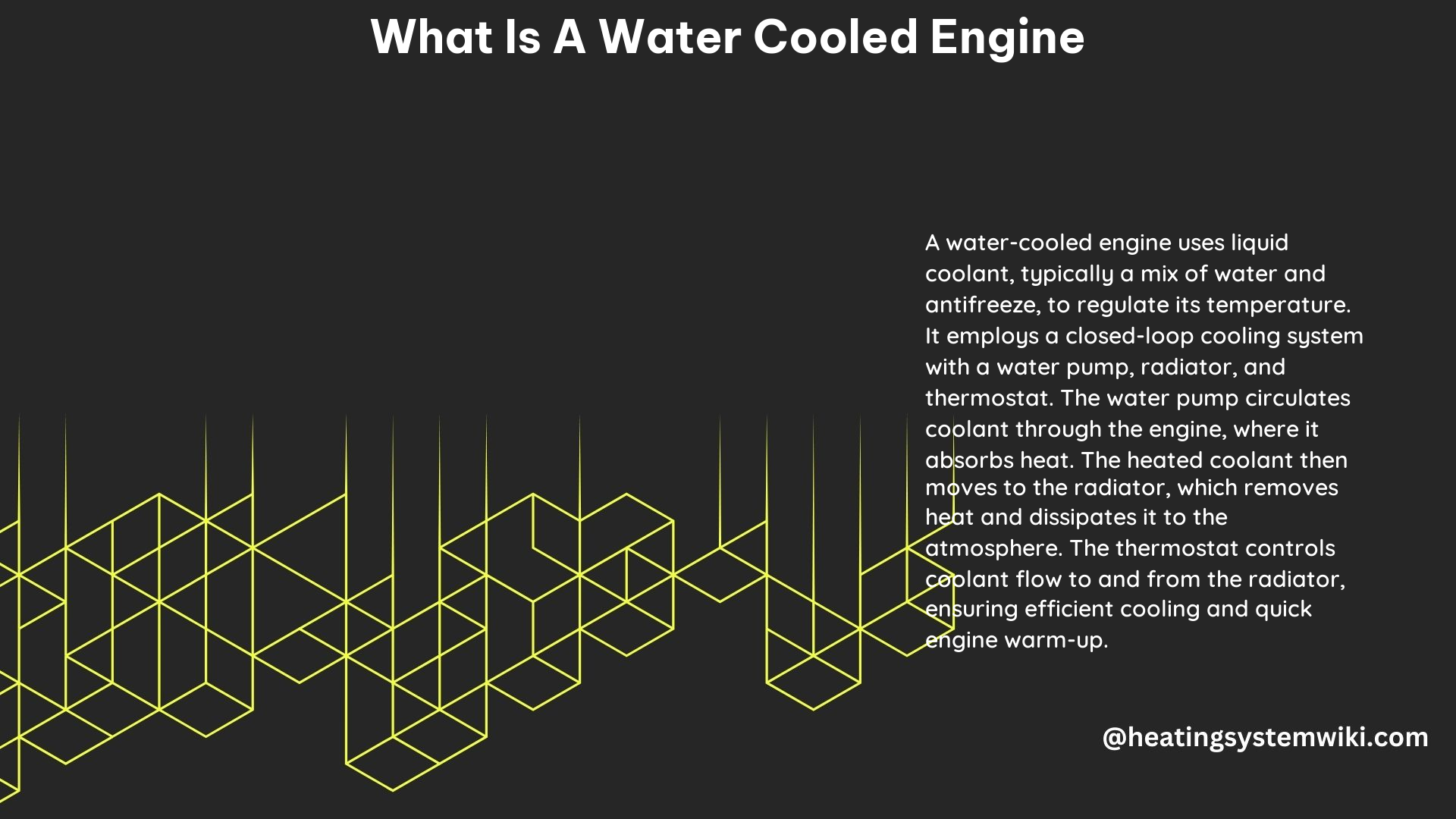A water-cooled engine is a type of internal combustion engine that uses a liquid coolant, typically a mixture of water and antifreeze, to regulate its temperature. The coolant is circulated through the engine and cooling system, absorbing heat produced by the combustion process and dissipating it through a radiator.
Understanding the Water Cooling System
The water-cooled engine employs a closed-loop cooling system that runs efficiently even when the car isn’t moving. The system includes various parts that work together to keep the engine running within a safe temperature range.
Water Pump
A water pump is a crucial component in a water-cooled engine. It moves the coolant through the engine and cooling system, ensuring that the heat generated by the combustion process is effectively absorbed and dissipated.
- The water pump is typically driven by a belt or chain connected to the engine’s crankshaft.
- It can circulate up to 30 gallons of coolant per minute, depending on the engine size and design.
- The water pump’s impeller design and rotational speed are optimized to provide the necessary coolant flow for efficient heat transfer.
Thermostat
The thermostat is another essential component in a water-cooled engine’s cooling system. It controls the movement of coolant to and from the radiator, ensuring that the cooling fluid enters the radiator at the right time and temperature.
- The thermostat is a temperature-sensitive valve that opens and closes based on the coolant temperature.
- When the engine is cold, the thermostat remains closed, allowing the coolant to bypass the radiator and circulate through the engine block to help the engine warm up more quickly.
- As the coolant temperature rises, the thermostat opens, allowing the heated coolant to flow through the radiator, where it can dissipate the heat.
- Thermostats are typically designed to open at a specific temperature, usually between 180°F and 195°F (82°C and 91°C), to maintain the optimal operating temperature for the engine.
Radiator
The radiator is a heat exchanger that removes heat from the coolant passing through its tubes and dissipates the thermal energy through its fins.
- Radiators are typically made of aluminum or copper-brass, which are highly efficient at transferring heat.
- The radiator’s design, including the size and shape of the tubes and fins, is optimized to maximize the surface area for heat dissipation.
- Radiators have a fan that forces air over their cooling fins, helping to dissipate the heat. The fan may be thermostatically controlled or run continuously.
- The airflow dynamics around the radiator are crucial for its efficiency, as the fan’s performance can be affected by the vehicle’s speed and the surrounding air pressure.
Coolant
The coolant used in a water-cooled engine is typically a mixture of water and antifreeze, also known as engine coolant.
- Antifreeze is added to the water to lower the freezing point and raise the boiling point of the coolant, allowing the engine to operate safely in a wider range of temperatures.
- Antifreeze also contains corrosion inhibitors and other additives that help protect the cooling system components from damage.
- The recommended coolant mixture ratio is typically 50% water and 50% antifreeze, but this can vary depending on the manufacturer’s specifications.
- It’s important to use the correct type and concentration of coolant, as specified by the engine manufacturer, to ensure optimal performance and protection.
Advantages of Water-Cooled Engines

Water-cooled engines offer several advantages over air-cooled engines:
- Consistent Temperature Control: Water-cooled engines can maintain a constant temperature regardless of whether the vehicle is moving, making them more suitable for high-performance applications.
- Improved Heat Dissipation: Water-cooled engines are more efficient at dissipating heat, allowing them to produce more power and operate at higher temperatures without risking damage.
- Compact Design: The use of a liquid coolant allows for a more compact engine design, as the cooling system can be integrated more efficiently.
- Quieter Operation: Water-cooled engines tend to be quieter than air-cooled engines, as the liquid coolant helps to dampen noise and vibrations.
Disadvantages of Water-Cooled Engines
While water-cooled engines offer several advantages, they also have some drawbacks:
- Complexity: Water-cooled engines are more complex than air-cooled engines, with additional components like the water pump, thermostat, and radiator.
- Maintenance: Water-cooled engines require more maintenance, such as regular coolant flushes and checks for leaks or other issues in the cooling system.
- Weight: The additional components and the coolant itself add weight to the engine, which can impact fuel efficiency and performance.
- Susceptibility to Failures: Water-cooled engines are more susceptible to cooling system failures, such as leaks or pump failures, which can be costly to repair.
DIY Maintenance Tips
If you own a water-cooled engine, there are several maintenance tasks you can perform to ensure it stays in good working order:
- Check Coolant Level: Regularly check the coolant level in the overflow tank or radiator and top it up as needed.
- Flush the Cooling System: Flush the cooling system every few years to remove any buildup or debris that could impede the flow of coolant.
- Inspect the Radiator and Fans: Check the radiator and cooling fans for any signs of damage or wear, and replace them if necessary.
- Inspect the Water Pump and Thermostat: Look for any signs of leaks or failure in the water pump and thermostat, and replace them if needed.
- Use High-Quality Coolant: Use a high-quality coolant that meets the manufacturer’s specifications, and follow the recommended maintenance schedule.
By performing these simple maintenance tasks, you can help ensure your water-cooled engine stays in good working order and continues to perform at its best.
References:
– Internal Combustion Engine Cooling
– Difference Between an Air-Cooled and Water-Cooled Engine
– Air-Cooled Engine vs. Liquid-Cooled Engine: Advantages and Disadvantages
– Engine Cooling Systems Explained
